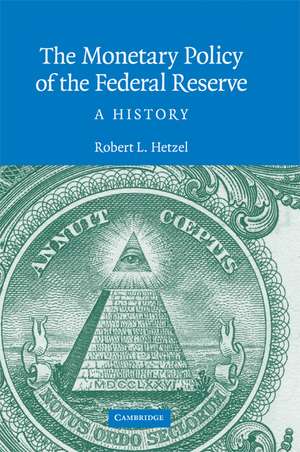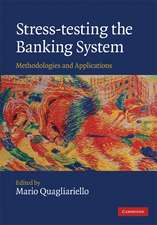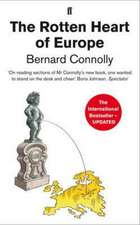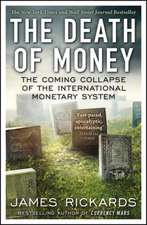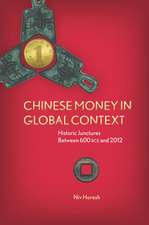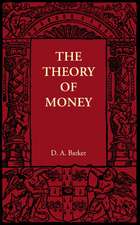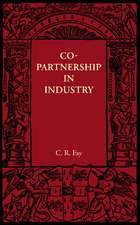The Monetary Policy of the Federal Reserve: A History: Studies in Macroeconomic History
Autor Robert L. Hetzelen Limba Engleză Hardback – 16 mar 2008
Din seria Studies in Macroeconomic History
-
![Teach Your Kids about Countries [Vol 5]: Version Adaptada Al Castellano Actual Por Rafael Antunez y Raul Alonso](https://i4.books-express.ro/bs/9781480268197/teach-your-kids-about-countries-vol-5.jpg) Preț: 61.51 lei
Preț: 61.51 lei -
 Preț: 72.83 lei
Preț: 72.83 lei -
 Preț: 92.61 lei
Preț: 92.61 lei -
 Preț: 40.48 lei
Preț: 40.48 lei -
 Preț: 104.33 lei
Preț: 104.33 lei -
![Teach Your Kids about Countries [Vol13]: Version Adaptada Al Castellano Actual Por Rafael Antunez y Raul Alonso](https://i2.books-express.ro/bs/9781480268272/teach-your-kids-about-countries-vol13.jpg) Preț: 61.51 lei
Preț: 61.51 lei -
 Preț: 46.84 lei
Preț: 46.84 lei -
 Preț: 125.81 lei
Preț: 125.81 lei -
 Preț: 135.03 lei
Preț: 135.03 lei -
 Preț: 131.58 lei
Preț: 131.58 lei -
 Preț: 63.20 lei
Preț: 63.20 lei - 9%
 Preț: 592.70 lei
Preț: 592.70 lei -
 Preț: 95.96 lei
Preț: 95.96 lei -
 Preț: 238.93 lei
Preț: 238.93 lei -
![Teach Your Kids about Countries [Vol 25]: Version Adaptada Al Castellano Actual Por Rafael Antunez y Raul Alonso](https://i0.books-express.ro/bs/9781480268401/teach-your-kids-about-countries-vol-25.jpg) Preț: 61.51 lei
Preț: 61.51 lei -
 Preț: 59.67 lei
Preț: 59.67 lei -
 Preț: 54.03 lei
Preț: 54.03 lei -
 Preț: 55.99 lei
Preț: 55.99 lei -
![Teach Your Kids about Countries [Vol4 ]: Version Adaptada Al Castellano Actual Por Rafael Antunez y Raul Alonso](https://i3.books-express.ro/bs/9781480268180/teach-your-kids-about-countries-vol4.jpg) Preț: 61.51 lei
Preț: 61.51 lei -
 Preț: 88.56 lei
Preț: 88.56 lei -
 Preț: 130.65 lei
Preț: 130.65 lei -
 Preț: 86.92 lei
Preț: 86.92 lei - 20%
 Preț: 45.72 lei
Preț: 45.72 lei -
 Preț: 83.38 lei
Preț: 83.38 lei -
 Preț: 212.46 lei
Preț: 212.46 lei -
 Preț: 56.92 lei
Preț: 56.92 lei -
 Preț: 177.10 lei
Preț: 177.10 lei -
 Preț: 62.62 lei
Preț: 62.62 lei -
 Preț: 74.52 lei
Preț: 74.52 lei -
 Preț: 123.49 lei
Preț: 123.49 lei -
![Teach Your Kids about Countries [Vol 17]: Version Adaptada Al Castellano Actual Por Rafael Antunez y Raul Alonso](https://i2.books-express.ro/bs/9781480268326/teach-your-kids-about-countries-vol-17.jpg) Preț: 61.51 lei
Preț: 61.51 lei -
![Teach Your Kids about Countries [Vol 22]: Version Adaptada Al Castellano Actual Por Rafael Antunez y Raul Alonso](https://i2.books-express.ro/bs/9781480268371/teach-your-kids-about-countries-vol-22.jpg) Preț: 61.51 lei
Preț: 61.51 lei -
![Teach Your Kids about Countries [Vol8]: Version Adaptada Al Castellano Actual Por Rafael Antunez y Raul Alonso](https://i2.books-express.ro/bs/9781480268227/teach-your-kids-about-countries-vol8.jpg) Preț: 61.70 lei
Preț: 61.70 lei -
 Preț: 208.23 lei
Preț: 208.23 lei -
 Preț: 96.04 lei
Preț: 96.04 lei -
 Preț: 96.45 lei
Preț: 96.45 lei -
![Teach Your Kids about Countries [Vol2]: Version Adaptada Al Castellano Actual Por Rafael Antunez y Raul Alonso](https://i1.books-express.ro/bs/9781480268166/teach-your-kids-about-countries-vol2.jpg) Preț: 61.51 lei
Preț: 61.51 lei -
 Preț: 69.21 lei
Preț: 69.21 lei -
 Preț: 64.79 lei
Preț: 64.79 lei -
 Preț: 95.31 lei
Preț: 95.31 lei -
 Preț: 51.11 lei
Preț: 51.11 lei -
 Preț: 51.36 lei
Preț: 51.36 lei -
 Preț: 75.99 lei
Preț: 75.99 lei -
 Preț: 78.74 lei
Preț: 78.74 lei -
 Preț: 93.90 lei
Preț: 93.90 lei -
 Preț: 167.96 lei
Preț: 167.96 lei -
 Preț: 53.96 lei
Preț: 53.96 lei -
 Preț: 71.19 lei
Preț: 71.19 lei
Preț: 470.07 lei
Preț vechi: 510.95 lei
-8% Nou
Puncte Express: 705
Preț estimativ în valută:
89.96€ • 93.80$ • 74.76£
89.96€ • 93.80$ • 74.76£
Carte disponibilă
Livrare economică 27 februarie-13 martie
Livrare express 13-19 februarie pentru 42.90 lei
Preluare comenzi: 021 569.72.76
Specificații
ISBN-13: 9780521881326
ISBN-10: 0521881323
Pagini: 408
Ilustrații: 50 tables
Dimensiuni: 156 x 234 x 27 mm
Greutate: 0.79 kg
Ediția:1
Editura: Cambridge University Press
Colecția Cambridge University Press
Seria Studies in Macroeconomic History
Locul publicării:New York, United States
ISBN-10: 0521881323
Pagini: 408
Ilustrații: 50 tables
Dimensiuni: 156 x 234 x 27 mm
Greutate: 0.79 kg
Ediția:1
Editura: Cambridge University Press
Colecția Cambridge University Press
Seria Studies in Macroeconomic History
Locul publicării:New York, United States
Cuprins
Foreword: what is the monetary standard?; 1. The pragmatic evolution of the monetary standard; 2. Learning and policy ambiguity; 3. From gold to fiat money; 4. From World War II to the Accord; 5. Martin and lean-against-the-wind; 6. Inflation is a nonmonetary phenomenon; 7. The start of the great inflation; 8. Arthur Burns and Richard Nixon; 9. Bretton Woods; 10. Policy in the Ford administration; 11. Carter, Burns, and Miller; 12. The political economy of inflation; 13. The Volcker disinflation; 14. Monetary policy after the disinflation; 15. Greenspan's move to price stability; 16. International bailouts and moral hazard; 17. Monetary policy becomes expansionary; 18. Departing from the standard procedures; 19. Boom and bust; 20. Backing off from price stability; 21. The Volcker–Greenspan regime; 22. The Fed: inflation fighter or inflation creator?; 23. The stop-go laboratory; 24. Stop-go and interest rate inertia; 25. Monetary nonneutrality in the stop-go era; 26. A century of monetary experiments.
Recenzii
'The Monetary Policy of the Federal Reserve: A History is a comprehensive study of the evolution of monetary policy practiced by the Federal Reserve since its founding nearly a century ago. Hetzel brings a unique perspective to this material, a monetarist point of view rooted in his U of Chicago training, but a view profoundly influenced by an understanding of monetary policy in practice acquired as a life-long policy advisor at the Federal Reserve Bank of Richmond. The story is one of a nominal anchor for monetary policy lost with the collapse of the gold standard and found after decades of monetary turbulence in the priority that the Federal Reserve puts on low inflation and in anchoring inflation expectations. Hetzel enriches the story with remarkable insights about Federal Reserve behavior and with key insights from the modern New Neoclasscial Synthesis (New Keynesian) theory of monetary policy. This is an amazing story, one that Hetzel tells in great detail and with great enthusiasm.' Marvin Goodfriend, Carnegie Mellon University
'An invaluable historical account of the history of U.S. monetary policy under the Federal Reserve System.' Robert G. King, Boston University
'Robert Hetzel's chronicle of the turning points in Federal Reserve conduct of monetary policy illuminates the problems that successive chairmen from William McChesney Martin on encountered in transforming the central bank into the modern Fed. Hetzel describes three monetary experiments beginning with a detour to the real bills doctrine, followed by decades of stop-go experience until the Paul Volcker-Alan Greenspan disinflation that ushered in a new monetary standard. Over time the Fed learned rule-like behavior that created expectations by the public of low stable inflation that is now the nominal anchor for a fiat money regime. It differentiates monetary policy as practiced before the 1980s from its practices since. Hetzel has written a path-breaking study.' Anna J. Schwartz, National Bureau of Economic Research
'The Monetary Policy of the Federal Reserve: A History by Robert Hetzel studies the evolution of monetary policy from the beginning of the Federal Reserve until the end of the Greenspan Era. The title claims the book is a history, and it is that, but it is much more. As a history, Hetzel's book details the conduct of monetary policy over nearly ninety years, and sets that conduct in the context of the intellectual and political environment of the time. As an economic synthesis, Hetzel's book views the evolution of monetary policies as a series of experiments useful for understanding fundamental issues concerning money, prices, and macroeconomic policy. The past serves as a laboratory for understanding the present. The emergence of modern monetary policy and prospects for our nation's financial future are understood by studying the learning-curve of the leaders of the Federal Reserve, the painful process of replacing the gold standard with a fiat money standard, and the recurrent monetary instability during the decades following the Second World War.' Gary Richardson, University of California in Irvine
'An invaluable historical account of the history of U.S. monetary policy under the Federal Reserve System.' Robert G. King, Boston University
'Robert Hetzel's chronicle of the turning points in Federal Reserve conduct of monetary policy illuminates the problems that successive chairmen from William McChesney Martin on encountered in transforming the central bank into the modern Fed. Hetzel describes three monetary experiments beginning with a detour to the real bills doctrine, followed by decades of stop-go experience until the Paul Volcker-Alan Greenspan disinflation that ushered in a new monetary standard. Over time the Fed learned rule-like behavior that created expectations by the public of low stable inflation that is now the nominal anchor for a fiat money regime. It differentiates monetary policy as practiced before the 1980s from its practices since. Hetzel has written a path-breaking study.' Anna J. Schwartz, National Bureau of Economic Research
'The Monetary Policy of the Federal Reserve: A History by Robert Hetzel studies the evolution of monetary policy from the beginning of the Federal Reserve until the end of the Greenspan Era. The title claims the book is a history, and it is that, but it is much more. As a history, Hetzel's book details the conduct of monetary policy over nearly ninety years, and sets that conduct in the context of the intellectual and political environment of the time. As an economic synthesis, Hetzel's book views the evolution of monetary policies as a series of experiments useful for understanding fundamental issues concerning money, prices, and macroeconomic policy. The past serves as a laboratory for understanding the present. The emergence of modern monetary policy and prospects for our nation's financial future are understood by studying the learning-curve of the leaders of the Federal Reserve, the painful process of replacing the gold standard with a fiat money standard, and the recurrent monetary instability during the decades following the Second World War.' Gary Richardson, University of California in Irvine
Descriere
The evolution of the monetary standard from the start of the Federal Reserve through the end of the Greenspan era.
